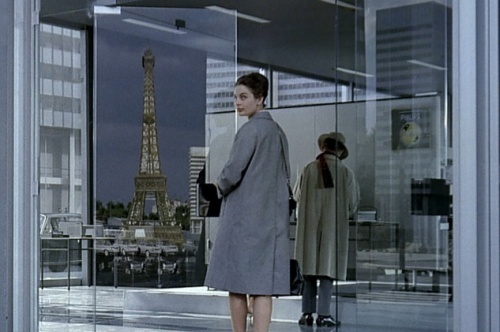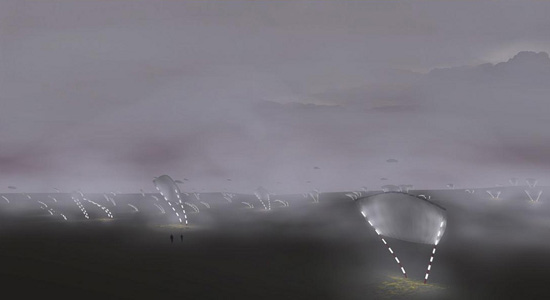 |
Dark glasses: Soladigm demonstrates an electrochromic window at its headquarters in California. An electric current has been applied to the pane on the left, limiting the amount of light and heat that can pass through.
Credit: Soladigm |
Windows that absorb or reflect light and heat at the flick of a switch could help cut heating and cooling bills. A company called
Soladigm has developed methods for making these "electrochromic" windows cheaply, making them more viable for homes and office buildings.
Existing electrochromic window designs cost around $100 per square foot. Soladigm has not disclosed how much its windows will cost, but some experts say the method could reduce the cost to around $20 per square foot.
The Milpitas, CA-based company uses a thin-film deposition process that creates conducting layers between two panes of glass for controlling the amount of sunlight and heat that can pass through. A homeowner or office dweller could control how much light or heat a window lets in or absorbs and reflects.
The company's windows contain two transparent conducting oxide films sandwiching an ion storage layer, an electrolyte, and an electrochromic layer--all between two layers of glass. Applying a low voltage to the conductive oxide kicks the ions out of the storage layer and across the electrolyte to meet with the electrochromic layer. The collision prompts the electrochromic material to absorb or reflect light. It also causes the material to darken, giving the window a tinted look. Reversing the voltage sends the ions back to its storage layer, causing the window to lighten in color and let more light in.
"We did a case study in five cities, and the average savings in commercial buildings are about 25 percent of the heating, ventilation, and air-conditioning energy use annually," says Rao Mulpuri, CEO of Soladigm.
The trick to making electrochromic windows cheaply is the right materials and latest manufacturing method, says Mulpuri. Today's thin-film deposition equipment--the same used to make flat panel display and thin-film solar panels--is much better than that used a few decades ago, when the electrochromic window concept emerged.
Soladigm will use a tungsten oxide-based electrochromic layer for its first windows. Tungsten oxide can endure repeated cycling between ion-rich and ion-free stages-which makes it durable, says Delia Milliron, a Lawrence Berkeley National Laboratory (LBNL) researcher in electrochromic materials. However, using tungsten oxide can heat up a window until it's too hot to touch; it also doesn't block infrared light very well, meaning it lets plenty of heat through.
Soladigm has licensed research from LBNL that could solve these problems. The research came from Tom Richardson, a researcher at LBNL's Advanced Energy Technologies Department who found novel alternatives to tungsten oxide. In one, a magnesium-based electrochromic layer reacts with hydrogen ions to reflect light. In another, an alloy of antimony with materials such as copper or silver is used with lithium ions to do the same. The reflective approaches not only prevent heat buildup, but also can precisely control the amount of visible and near-infrared light that the window blocks, Richardson says.
Either approach could better control the amount of heat from near infrared, making it possible to significantly warm up a room in cold days. "There might be time when you want light blocked but you want the near-infrared to get in. In the winter, you want light and the heat to warm up the house, so having the ability to switch both or independently will be ideal," Richardson says.
The ability to manage the amount of light and heat that gets into a room sets electrochromic windows apart from low-emittance, or low-E, windows. Low-E windows have a metal oxide coating that reflects near-infrared light and allows most visible light to pass through. These windows generally cost around $10 per square foot.
Some experts say that installing electrochromic windows could cost considerably more than installing low-E windows for certain types of buildings. "To do a whole façade, you would have to run electricity to each window, and that might be cost-prohibitive," says Aaron Smith, a researcher in the Lighting Research Center of Rensselaer Polytechnic Institute. "It also would be more difficult to install them when retrofitting older buildings."
Copyright Technology Review 2010.








